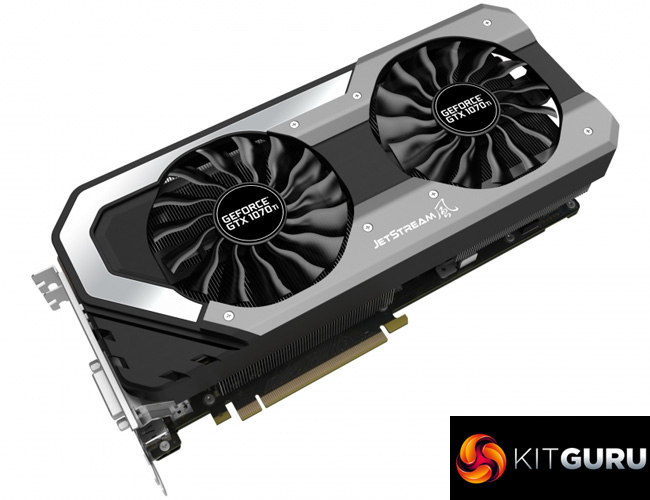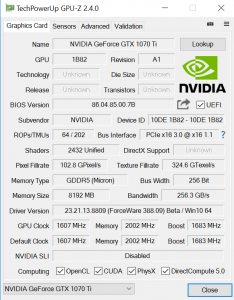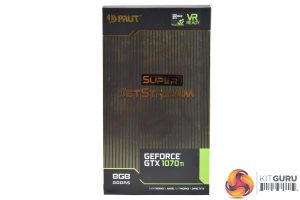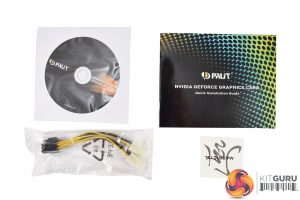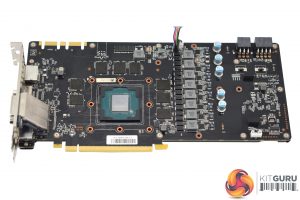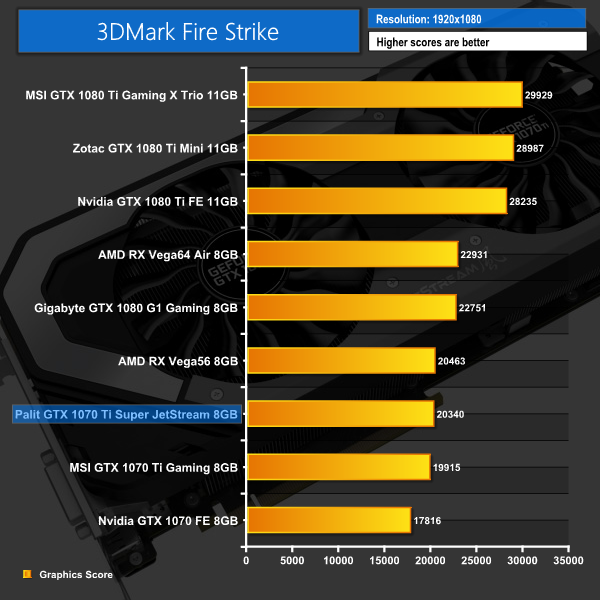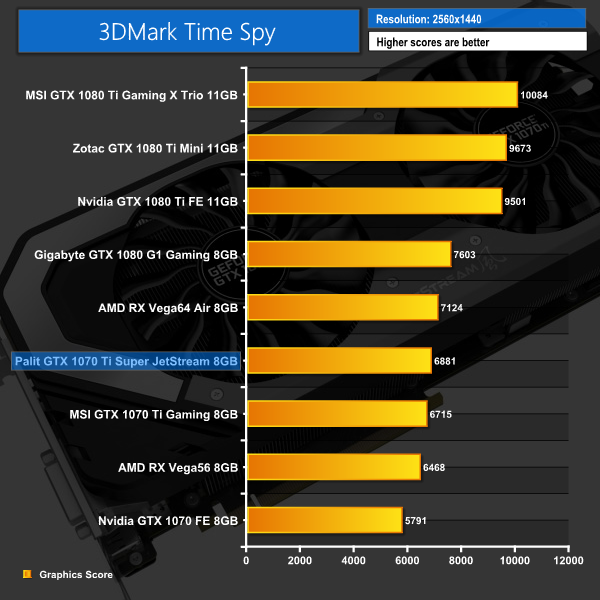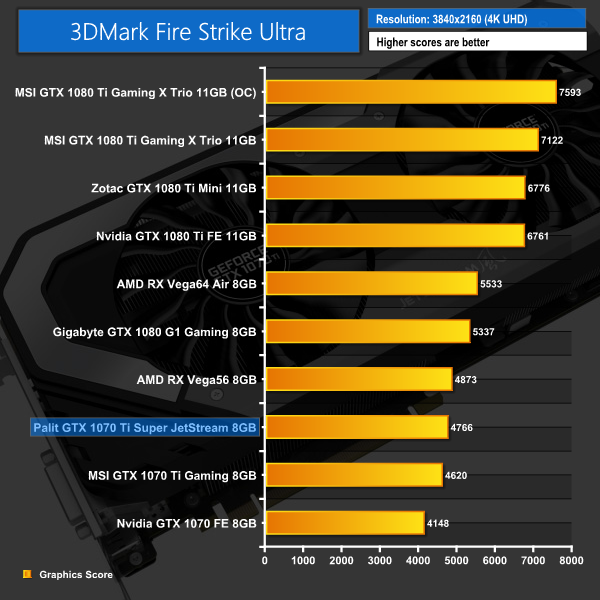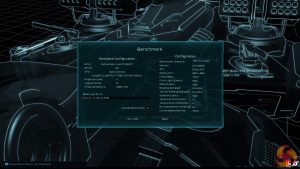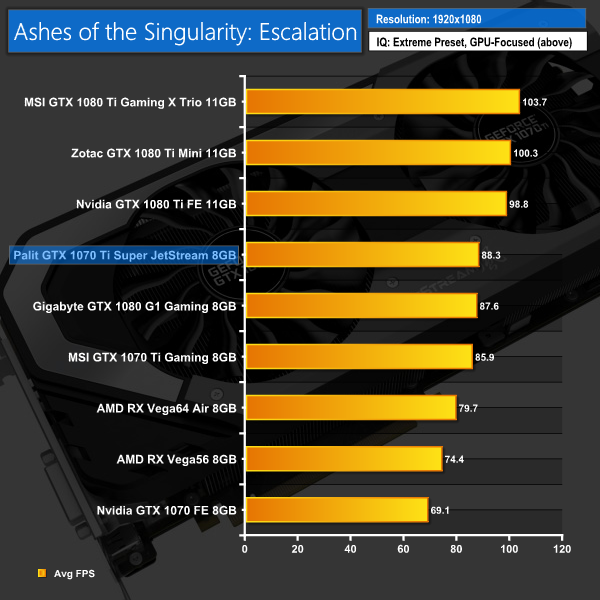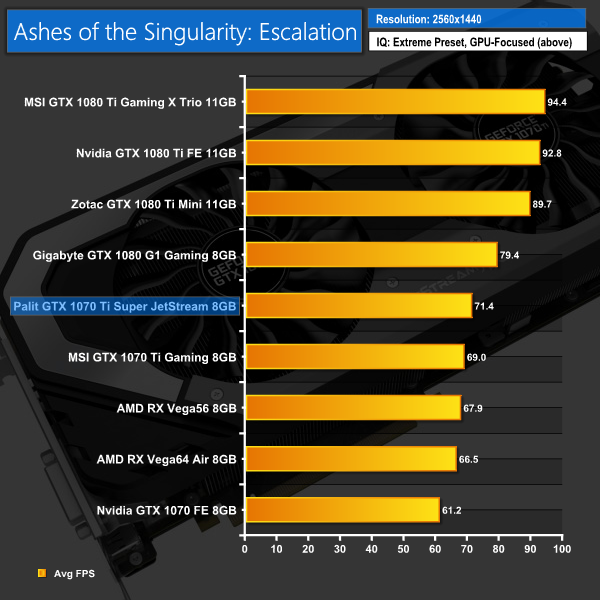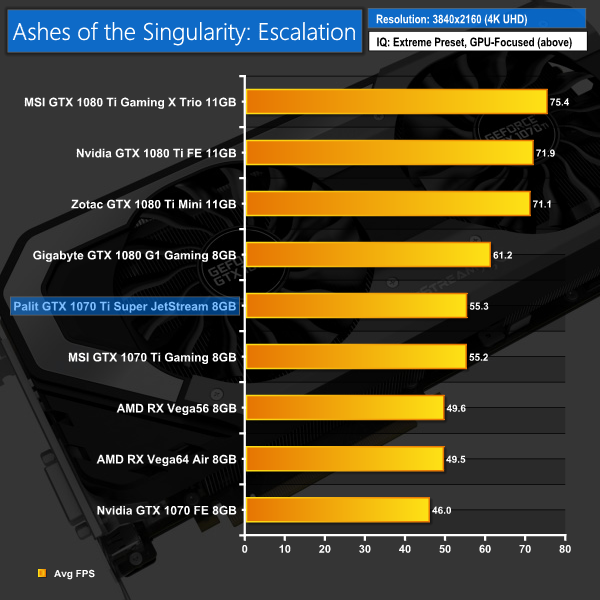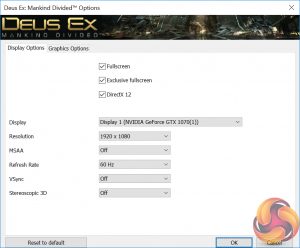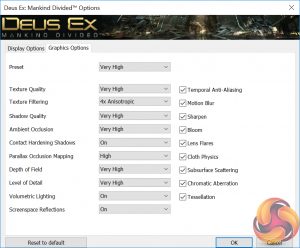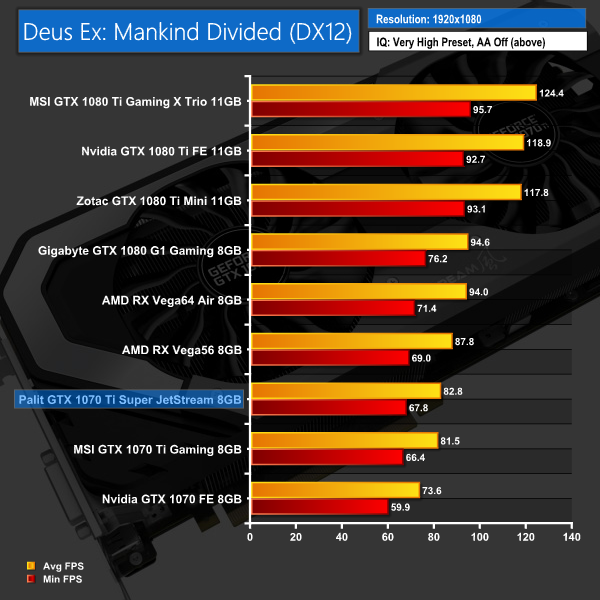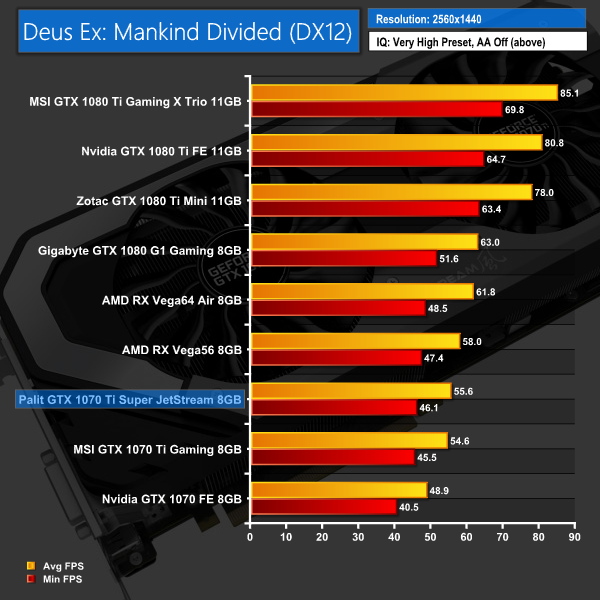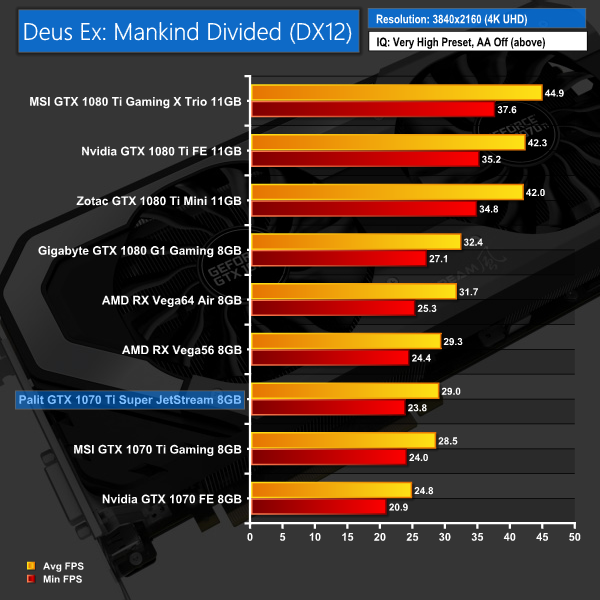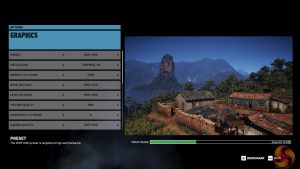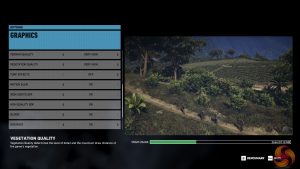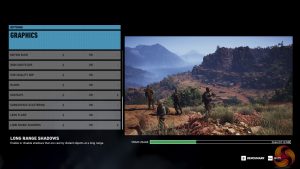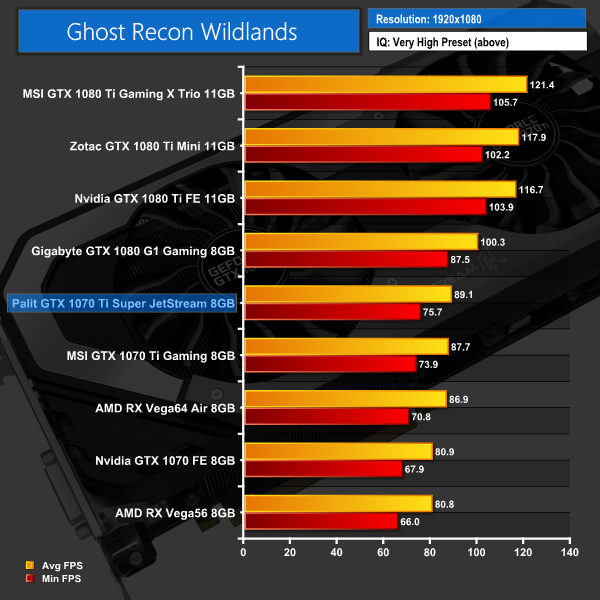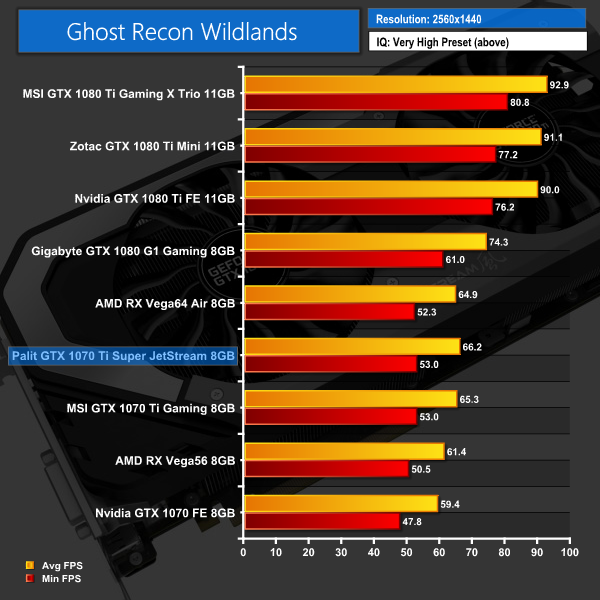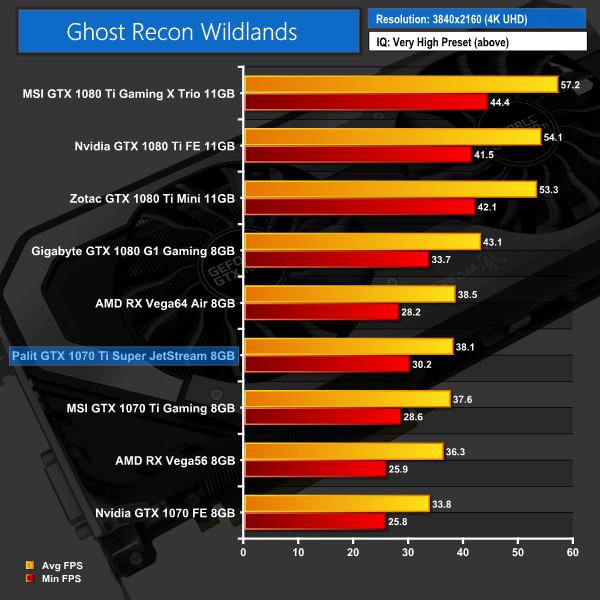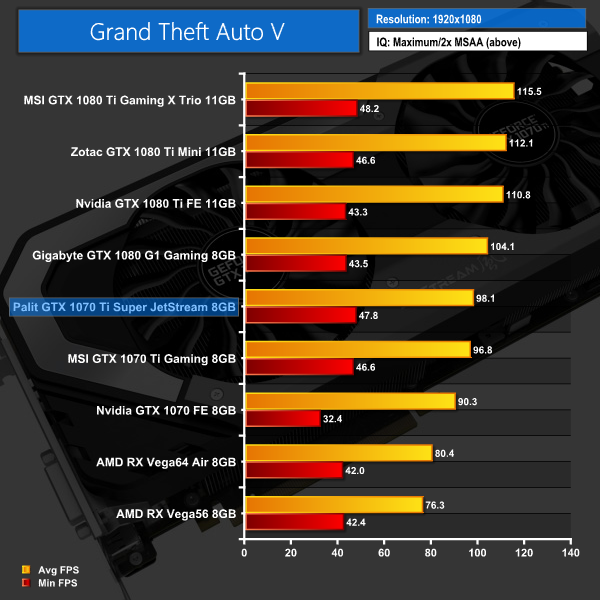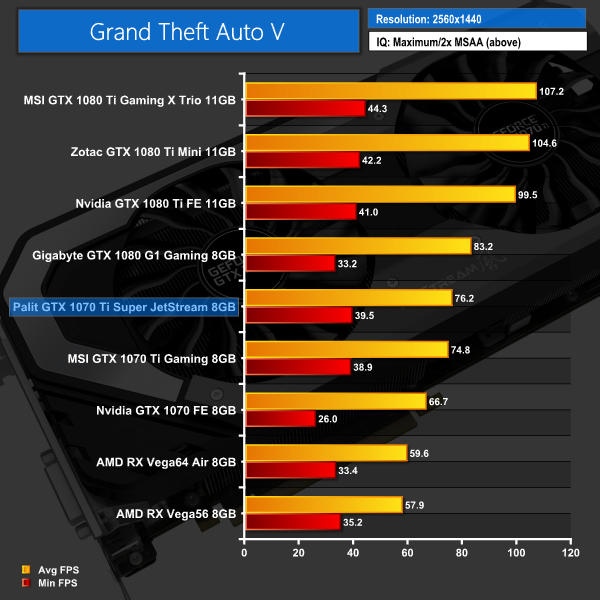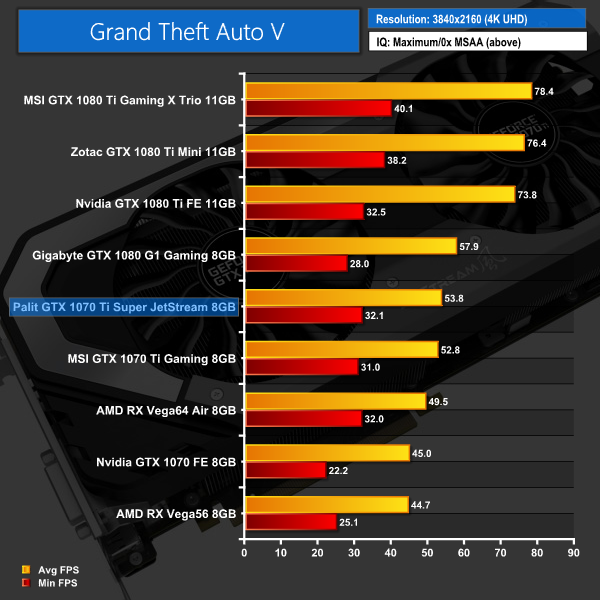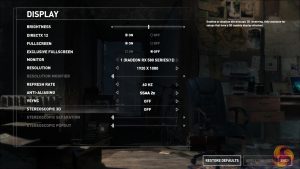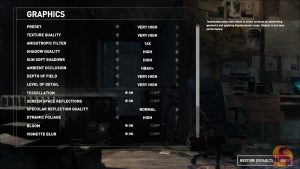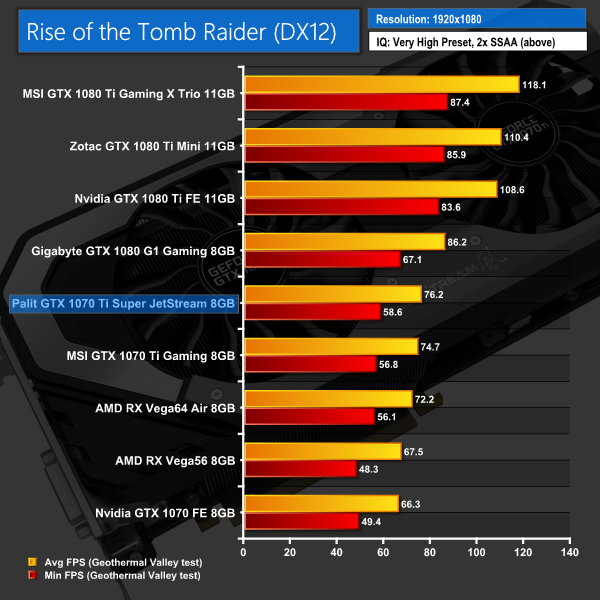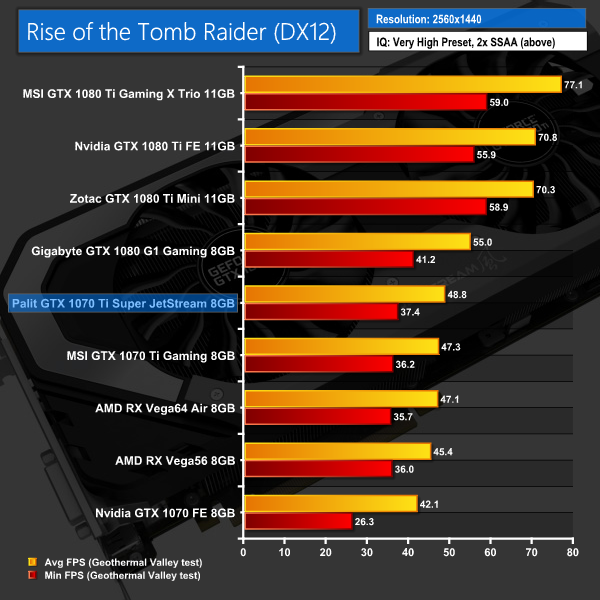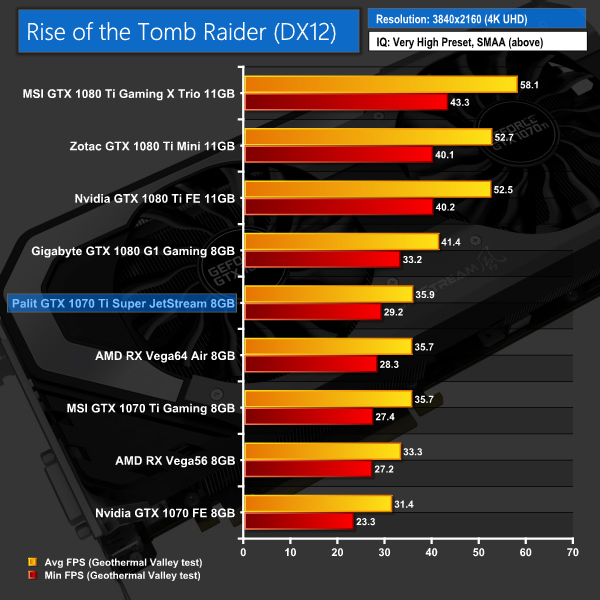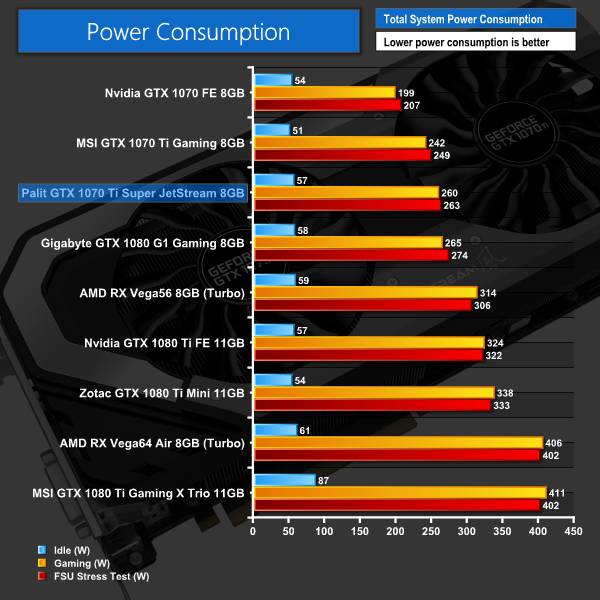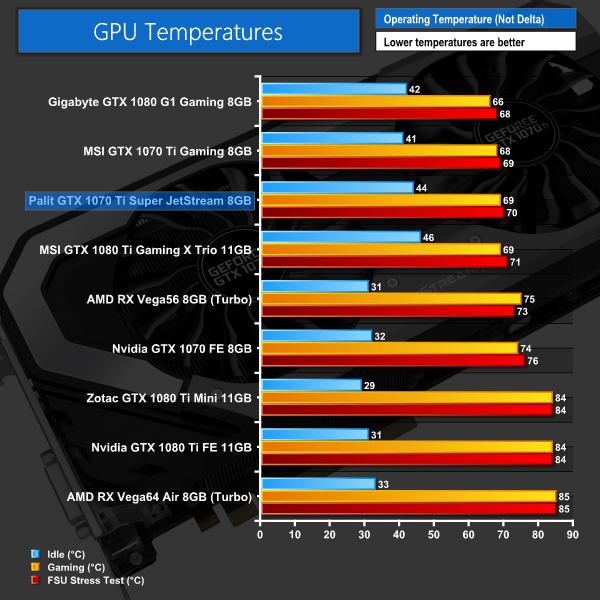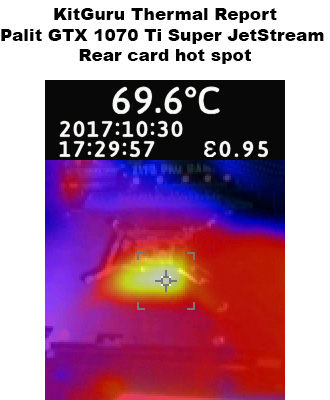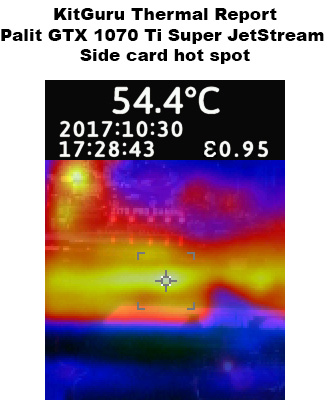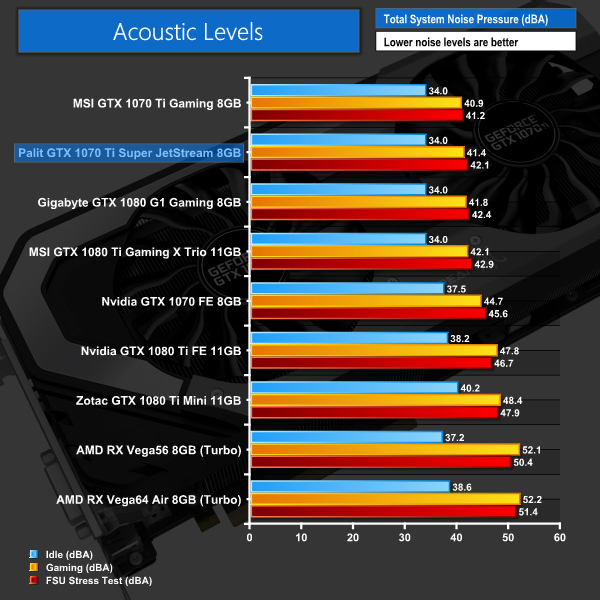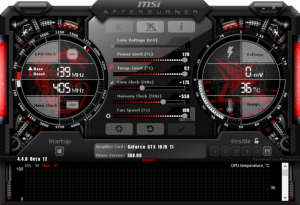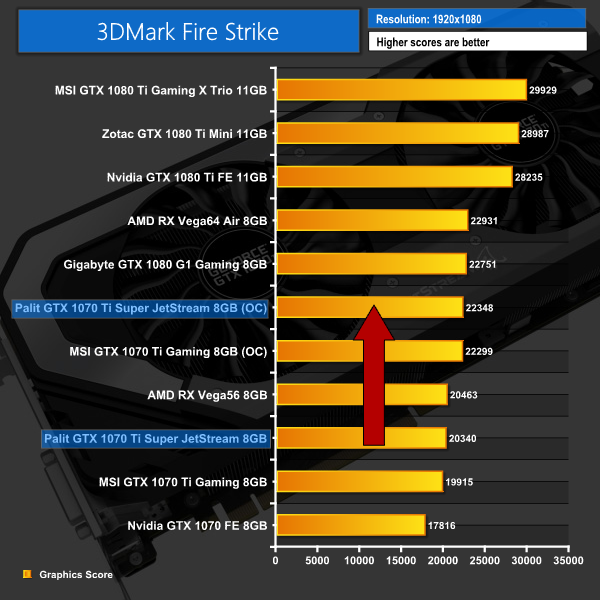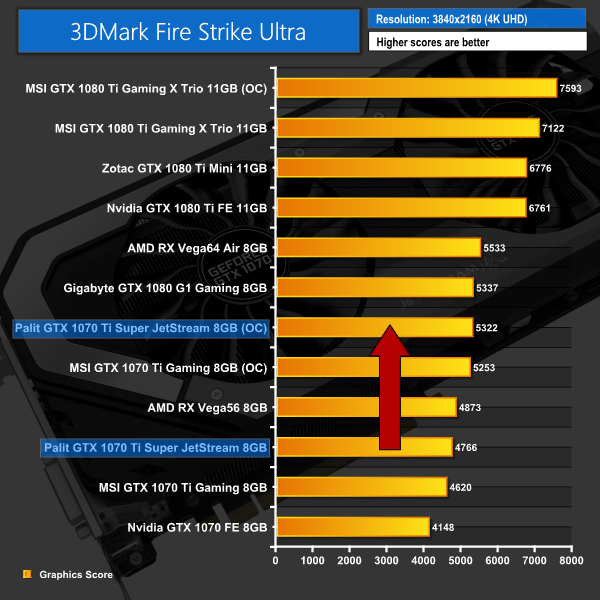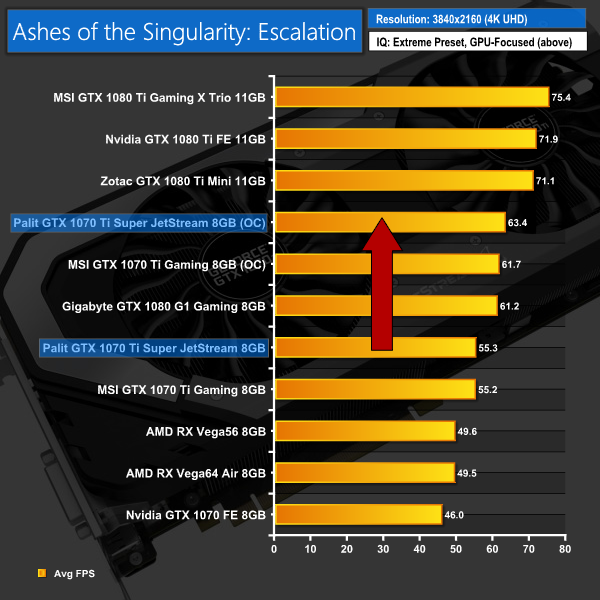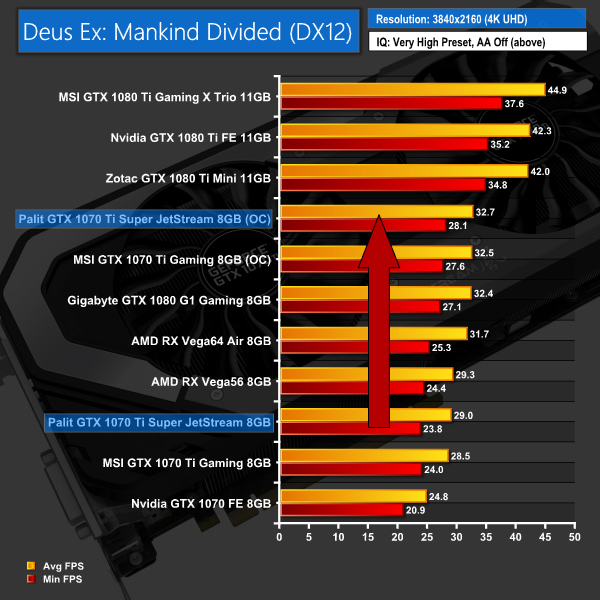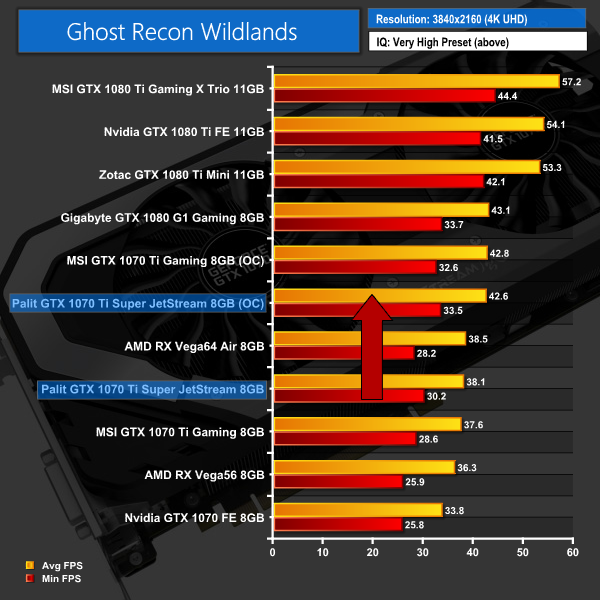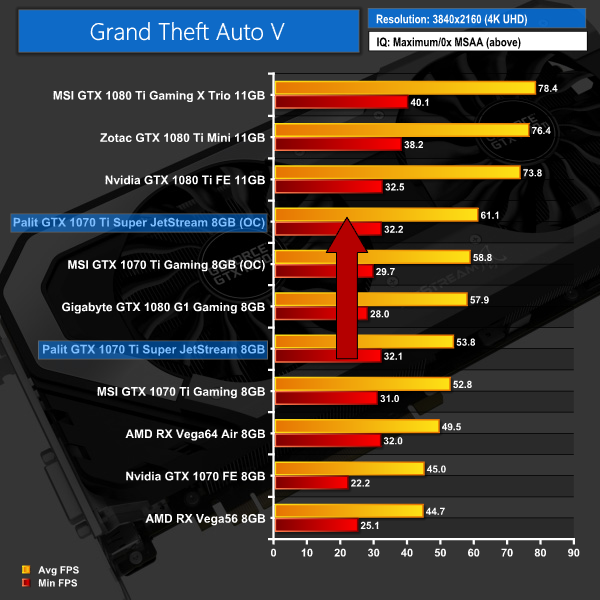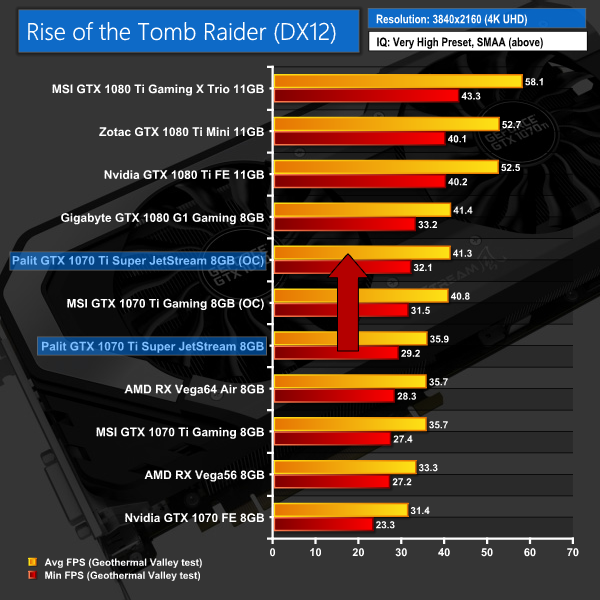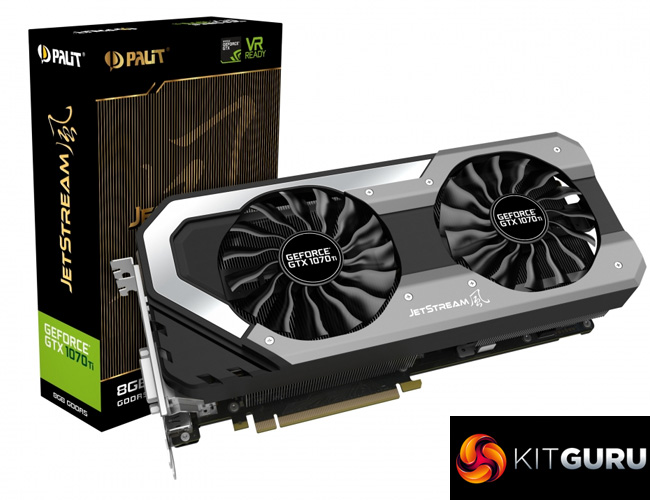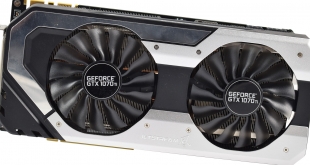
Today we have reviews of two GTX 1070 Ti aftermarket cards ready for launch – this one is the Palit Super JetStream model. If it looks familiar, that would be because we did an unboxing video of the card last week, but this review is very much focused on performance – so just how good is the Palit Super JetStream, and is it worth buying?
Another partner card with a custom cooling solution, the Palit GTX 1070 Ti Super JetStream is a hefty 2.5-slot graphics card – something that could well give it the edge over its dual-slot rivals. After all, we know that all GTX 1070 Tis are currently shipping with the same base and boost frequencies, and that means the cards with the best cooling solutions will also get the best gaming performance thanks to the way GPU Boost 3.0 dynamically adjusts core clock based on core temperature.
| GPU | Geforce GTX 1070 Ti | Geforce GTX 1080 | Geforce GTX 1070 |
| CUDA Cores | 2432 | 2560 | 1920 |
| Base Clock | 1607 MHz | 1607 MHz | 1506 MHz |
| GPU Boost Clock | 1683 MHz | 1733 MHz | 1683 MHz |
| Total Video memory | 8GB GDDR5 | 8GB GDDR5X | 8GB GDDR5 |
| Memory Clock | 4004 MHz | 5005 MHz | 4006 MHz |
| Memory Bandwidth | 256GB/s | 320GB/s | 256GB/s |
| Bus Width | 256 | 256bit | 256 bit |
| ROPs | 64 | 64 | 64 |
| Manufacturing Process | 16nm | 16nm | 16nm |
| TDP | 180 Watts | 180 Watts | 150 Watts |
The Palit GTX 1070 Ti Super JetStream ships in a reflective gold box, with both the Palit branding and Super JetStream text written in gold lettering.
Inside, there is a pretty standard selection of accessories including 1x driver disc, 1x quick start guide, 1x PCIe power adaptor and 1x sticker.
The card itself is very attractive, with a monochrome silver and black colour scheme. It is very colour neutral and should look good in any rig.
As for the cooling solution, the Super JetStream utilises two 100mm fans which blow directly onto a dense fin array. As mentioned previously, this is a 2.5-slot card, so it just has that extra bit of space to accommodate a larger heatsink.
Looking at either side of the card, you actually get a good idea of how thick the heatsink is – the fin array is very densely stacked and spans most of the length of the PCB.
Taking the card apart reveals a relatively plain-looking PCB – no extra contact plates on the VRAM or VRMs here.
The cooler is very beefy, though, with its 5 copper heatpipes and copper contact area. There are also thermals pads in-place for the VRAM and chokes.
Turning to the top of the card, we can see Palit has fitted a very plain metal backplate. This should provide some rigidity, but I do wonder why they added in a cut-out directly behind the GPU core – we will have a look at thermals later in the review, but I would've thought having a full-cover backplate would help heat dissipate better.
Elsewhere, this Super JetStream card uses 1x 6-pin and 1x 8-pin PCIe power connectors, with its TDP rated at 180W.
Lastly, the display outputs are left as standard: 3x DisplayPort 1.4, 1x HMDI 2.0b, 1x DVI-D.Our newest GPU test procedure has been built with the intention of benchmarking high-end graphics cards. We test at 1920×1080 (1080p), 2560×1440 (1440p), and 3840×2160 (4K UHD) resolutions.
We try to test using the DX12 API if titles offer support. This gives us an interpretation into the graphics card performance hierarchy in the present time and the near future, when DX12 becomes more prevalent. After all, graphics cards of this expense may stay in a gamer’s system for a number of product generations/years before being upgraded.
We tested the RX Vega64 and Vega56 using the ‘Turbo‘ power mode in AMD’s WattMan software. This prioritises all-out performance over power efficiency, noise output, and lower thermals.
General Test System Notes
- AMD Graphics cards were benchmarked with the AMD Crimson ReLive 17.9.1 driver.
- Nvidia Graphics cards, not including GTX 1070 Ti cards, were benchmarked with the Nvidia 384.94 driver.
- GTX 1070 Ti cards were benchmarked with the Nvidia 388.09 driver.
Test System
| CPU |
Intel Core i7-7700K ‘Kaby Lake’ (Retail)
Overclocked to 4.8GHz Core |
| Motherboard |
ASUS Z170 Pro Gaming
|
| Memory |
Geil Evo X
16GB (2x8GB) @ 3200MHz 16-16-16-36 |
| Graphics Card |
Varies
|
| System Drive |
Sandisk SSD PLUS 120GB
|
| Games Drive | Crucial M4 512GB |
| Chassis | Game Max Moonstone (high fan speed) |
| CPU Cooler |
Fractal Design Celsius S24
|
| Power Supply |
Seasonic Prime 1000W Platinum
|
| Operating System |
Windows 10 Professional with Creators’ Update (64-bit)
|
Our test system consists of an overclocked Core i7-7700K processor and 16GB of 3200MHz Geil DDR4. High-end hardware is used to eliminate CPU and memory from the bottleneck equation and put the performance onus solely on the GPU being tested.
Comparison Graphics Cards List
AMD Radeon RX Vega64 Air (1247MHz core / 1546MHz average boost / 1.89Gbps HBM2 memory)
AMD Radeon RX Vega56 Air (1156MHz core / 1471MHz average boost / 1.6Gbps HBM2 memory)
Nvidia GTX 1080 Ti Reference (1480MHz core / 1582MHz boost / 11Gbps GDDR5X memory)
Zotac GTX 1080 Ti Mini (1506MHz core / 1620Mhz boost / 11Gbps GDDR5X memory)
MSI GTX 1080 Ti Gaming X Trio (1569MHz core / 1683MHz boost / 11Gbps GDDR5X memory)
Gigabyte GTX 1080 G1 Gaming (1696MHz core/ 1835MHz boost / 10Gbps GDDR5X memory)
MSI GTX 1070 Ti Gaming 8G (1607MHz core / 1683HMz boost / 8Gbps GDDR5
Nvidia GTX 1070 Founders Edition (1506MHz core/ 1683MHz boost / 8Gbps GDDR5 memory)
Software and Games List
- 3DMark Fire Strike & Fire Strike Ultra (DX11 Synthetic)
- 3DMark Time Spy (DX12 Synthetic)
- Ashes of the Singularity: Escalation (DX12)
- Deus Ex: Mankind Divided (DX12)
- Ghost Recon Wildlands (DX11)
- Grand Theft Auto V (DX11)
- Rise of the Tomb Raider (DX12)
3DMark Fire Strike is a showcase DirectX 11 benchmark designed for today’s high-performance gaming PCs. It is our [FutureMark’s] most ambitious and technical benchmark ever, featuring real-time graphics rendered with detail and complexity far beyond what is found in other benchmarks and games today.
The Palit 1070 Ti gets off to a decent start with 3DMark – it edges ahead of the MSI 1070 Ti that we also reviewed for launch day, but the GTX 1080 is still a decent way ahead.Ashes of the Singularity: Escalation is a real-time strategy game set in the future where descendants of humans (called Post- Humans) and a powerful artificial intelligence (called the Substrate) fight a war for control of a resource known as Turinium.
Players will engage in massive-scale land/air battles by commanding entire armies of their own design. Each game takes place on one area of a planet, with each player starting with a home base (known as a Nexus) and a single construction unit.
We opt for the Extreme quality profile and run the GPU-Focused test using the DX12 game mode.
Ashes proved amenable to the Palit 1070 Ti – it actually just edge ahead of our Gigabyte GTX 1080 at 1080p. I looked into this closely as it was an interesting result, and it would seem the 1080p benchmark allowed the card to dynamically boost its frequency into the 1900MHz range – which then took the performance just past the 1080.
At 1440p and 4K, though, the load on the GPU is much greater and the Palit card did not boost as high and so the 1080 again edged back ahead.Deus Ex: Mankind Divided is set in the year 2029, two years after the events of Human Revolution and the “Aug Incident”—an event in which mechanically augmented humans became uncontrollable and lethally violent.
Unbeknownst to the public, the affected augmented received implanted technology designed to control them by the shadowy Illuminati, which is abused by a rogue member of the group to discredit augmentations completely. (Wikipedia).
The Very High preset was used for 1080P, 1440P, and 4K. We used the DirectX 12 API.
We know Deus Ex favours AMD graphics, so it not surprising to see both Vega56 and Vega64 beat the Super JetStream at 1440p and 4K. This Palit models still posts higher frame rates than the MSI Gaming 8G, though.Tom Clancy’s Ghost Recon: Wildlands is an open world tactical shooter video game developed by Ubisoft Paris. It is the tenth instalment in the Tom Clancy’s Ghost Recon franchise and is the first Ghost Recon game to feature an open world environment.
We run the built-in benchmark using the Very High quality preset at 1080P, 1440P, and 4K.
Wildlands is more favourable to Nvidia hardware so here we see the 1070 Ti stay ahead of Vega56 across all three resolutions tested. At 1080p, the Super JetStream even beats Vega64.Grand Theft Auto V is an action-adventure game played from either a first-person or third-person view. Players complete missions—linear scenarios with set objectives—to progress through the story. Outside of missions, players may freely roam the open world.
Composed of the San Andreas open countryside area and the fictional city of Los Santos, the world is much larger in area than earlier entries in the series. It may be fully explored after the game’s beginning without restriction, although story progress unlocks more gameplay content.
We use the Ultra quality settings (or the highest alternative – generally Very High or High – when Ultra is unavailable). MSAA is set to 2x for 1080p and 1440p and is disabled for 4K. The Advanced Graphics options are all set to their maximum levels.
GTA V is another positive showing for the Super JetStream, with it outperforming both Vega cards as well as MSI's 1070 Ti offering.Rise of the Tomb Raider is a third-person action-adventure game that features similar gameplay found in 2013’s Tomb Raider. Players control Lara Croft through various environments, battling enemies, and completing puzzle platforming sections, while using improvised weapons and gadgets in order to progress through the story.
It uses a Direct X 12 capable engine.
At 1080p and 1440p, we use the Very High quality preset and 2x SSAA. At 4K we use SMAA. The DirectX 12 API is used. Numbers are taken from the benchmark’s Geothermal Valley test.
Our last game today, ROTTR is another game favourable to Palit's 1070 Ti – it again beats both Vega cards and the MSI 1070 Ti Gaming 8G.We first measure system-wide power draw from the wall while the card is sat idling at the Windows 10 desktop for 5 minutes. Gaming power draw is recorded by running the Deus Ex benchmark at 4K. As a maximum stress test, Fire Strike Ultra Stress Test is run 5 consecutive times and the cards’ power draws are recorded.
The Palit Super JetStream does draw slightly more power than its MSI 1070 Ti rival, but that is likely because the Palit can sustain higher clock speeds than the MSI card. In any case, it is no surprise to see the Palit 1070 Ti drawing more than a reference 1070 but less than an aftermarket 1080.We first measure GPU temperature while the card is sat idling at the Windows 10 desktop for 5 minutes. Gaming GPU temperature is recorded by running the Deus Ex benchmark at 4K. As a maximum stress test, Fire Strike Ultra Stress Test is run 5 consecutive times and the cards’ GPU temperature levels are recorded.
Ambient room temperature was held at around 23°C.
Another good showing for the Super JetStream here, I did not see it run hotter than 70C which is an excellent result. Like the MSI Gaming 8G, it also sports a ‘zero dB' mode, where the fans don't spin under low loads – that explains the 44C idle temperature, as the fans simply shut off.
Moving on to thermal imaging camera, the first thing to note is the higher 69.6C hotspot on the rear of the card. This is the area directly behind the GPU core, so it is not surprise to see it getting quite warm. If Palit had covered the back of the GPU with the backplate, I'd wager the hotspot would be lower as there would be more surface area for the heat to dissipate.
On the side of the card, a hotspot there of 54.4C is nothing to worry about at all.
We take our noise level measurements with the decibel meter on the top and middle section of the case, overhanging the side panel (power supply side, not motherboard tray side) by exactly 1 inch to avoid any airflow pressure coming from the exhausting AIO cooler.
I measured the sound floor to be 34 dBA, thus anything above this level can be attributed to the graphics cards. The power supply is passive for the entire power output range we tested all graphics cards in, while all CPU and system fans were disabled.
Noise levels were measured after 5 minutes under three scenarios: desktop idle, Deus Ex: Mankind Divided at 4K, and the Fire Strike Ultra stress test.
Barely coming in louder than the MSI Gaming 8G, the noise levels of the Palit 1070 Ti are very good. It also benefits from the ‘zero dB' mode so low-load tasks like web browsing can be done in silence.
Coming to manual overclocking, this is a key area for all 1070 Tis – with the right overclock, a 1070 Ti should perform very similarly to a GTX 1080.
My best overclock came with power and temperature sliders maximised, fans at 100%, +175MHz to the GPU core and +550MHz to the memory. In practice, this meant the card's frequency hovered around the 2GHz mark, flitting between 2004-2030MHz. At stock settings, it would stabilise at around 1830MHz.
To find out the benefit of this overclock, I re-ran all of our games at 4K resolution, as well as Fire Strike and Fire Strike Ultra.
As you can see above, an overclocked Palit Super JetStream essentially delivers stock GTX 1080 performance. It nudges ahead in some tests, falls just behind in others – but looking at the big picture, the margin of difference is very small.One of two aftermarket GTX 1070 Tis we have reviewed for launch day, the Palit GTX 1070 Ti Super JetStream is a very effective implementation of the GP104 chip.
It is a good-looking card with its monochrome, silver and black colour scheme – it should fit in almost any system as it is very colour neutral.
Palit opted for a 2.5-slot design, with a hefty heatsink, and the card performs very well in terms of thermal performance and acoustics. I do have to question the cut-out in the backplate behind the GPU core, as our thermal imaging showed this to be a significant hotspot on the back of the card, but it is still not a worry.
In terms of actual gaming performance, our testing proves that the Palit card is actually faster than the MSI Gaming 8G variant – not by much, but usually by around 1-2 FPS. This would be because the Palit card can keep the GPU core cooler (thanks to its thicker heatsink) and that allows GPU Boost 3.0 to push the clock speed further.
Overclocking also brought tangible gains, and just like the MSI 1070 Ti, an overclocked Palit 1070 Ti performs essentially the same as a stock GTX 1080 – so overclocking really does unlock that extra performance tier.
However, while my view of the Super JetStream is very positive, pricing is another concern. If you came to this review after reading the MSI Gaming 8G review, you will know my opinion on the matter – simply put, aftermarket 1070 Ti cards are currently too pricey, with some even costing more than aftermarket GTX 1080 cards. This is clearly an unfortunate situation to be in, as a 1080 is obviously the better buy if the pricing is the same, thus rendering the 1070 Ti obsolete before it's even launched.
We don't yet have a confirmed price for the Super JetStream as it has not yet appeared online – so I would advise our readers to be cautious. An aftermarket GTX 1070 Ti, like this one, at around the £430-440 mark would be a good buy. However, with prices currently closer to £500 – and thus far too close to GTX 1080 – GTX 1070 Ti just isn't worth the cash.
Pros
- Good-looking card.
- Faster than MSI's 1070 Ti out-of-the-box.
- Overclocks well, to essentially GTX 1080 levels of performance.
- Cool and quiet.
Cons
- Pricing is unclear and would have to be a fair bit less than other aftermarket cards to be good value.
- Hotspot on rear of card behind the GPU core.
KitGuru says: With the right pricing, the Palit GTX 1070 Ti Super JetStream could be a very attractive proposition. We will just have to wait and see.
Be sure to check out our sponsors store EKWB here
 KitGuru KitGuru.net – Tech News | Hardware News | Hardware Reviews | IOS | Mobile | Gaming | Graphics Cards
KitGuru KitGuru.net – Tech News | Hardware News | Hardware Reviews | IOS | Mobile | Gaming | Graphics Cards


